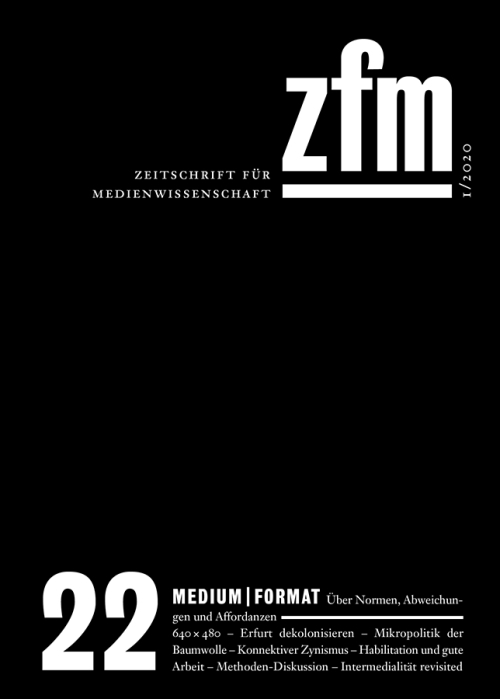InDesign als Methode?
Wahrnehmungstheoretische Überlegungen zu analogen und digitalen Displaykulturen der Fotografie
Abstract (Deutsch)
Fotografische Installationsansichten hat man in ihrer Relevanz für die zeitgenössische Kunst seit den 1960er Jahren mehrfach untersucht. Als zukünftige Referenz und als Selbsthistorisierung wurde der Installation shot zu einem Akt der räumlichen Inszenierung, den die Fotografie freilich in die Fläche klappte und dem Ausstellungsraum nur noch Wände gab. Hier sehe ich die Referenz zum Fotobuch als Display: Während das Installationsfoto die Wand als Rahmen, als Hintergrund akzentuiert, ist es im Fotobuch der Weißraum der Seite, der gleichermaßen als Display akzeptiert wird: Als Fläche, die sowohl in der Höhe als auch in der Breite variabel bespielbar ist und tendenziell unendlich gedacht wird. Die Konditionen des Kubus‘ werden im Buch auf die Doppelseite projiziert, die nun den neuen Rahmen, die neue Wand darstellt. Dass diese Wand in vielen Layoutvorlagen gerastert ist und die auf ihr platzierten Rechtecke, die wieder nur aus Rechtecken bestehen, sich diesem Raster beugen müssen, hat – und sei es als Einspruch – Einfluss auf die Bildevidenz und die mit ihr verbundene Sequenz. Auch hier findet eine multimediale Transformation statt, die ihre analogen Wurzeln digital zuspitzen konnte: InDesign macht es möglich, den Weißraum der Seite völlig flexibel und variabel zu gestalten. Anhand der Fotograf_innen Susanne Brügger, Volker Heinze und Roe Ethridge wird der Beitrag zeigen, wie das Buch als kulturelles Dispositiv im Fotobuch digital herausgefordert wird und zwar vor und nach digitalen Layoutprogrammen wie InDesign.
Abstract (English)
InDesign as a Method? The Photobook and Displays
The relevance of photographic installation views for contemporary art has been examined several times since the 1960s. As a future reference and self-historization, the installation shot became an act of spatial staging, which photography admittedly folded into the surface and gave the exhibition space only walls. Here I see the reference to the photobook as a display: while the installation photo accentuates the wall as a frame, as a background, in the photobook it is the white space of the page, which is accepted equally as a display: As a surface that can be played on variably in height as well as in width and that tends to be thought of infinitely. The conditions of the cube are projected onto the double page in the book, which now represents the new frame, the new wall. The fact that this wall is rasterized in many layout templates and that the rectangles placed on it, and consisting only of rectangles, have to bend to this raster has – even as an objection – an influence on the image evidence and the sequence associated with it. Here, too, a multimedia transformation is taking place that has been able to digitally sharpen its analog roots: InDesign and comperable softwares makes it possible to make the white space of the page completely flexible and variable. With the help of photographers Susanne Brügger, Volker Heinze and Roe Ethridge, the contribution will show how the book is digitally challenged as a cultural device in the photobook, before and after digital layout programs such as InDesign.
Bevorzugte Zitationsweise:
Die Open-Access-Veröffentlichung erfolgt unter der Creative Commons-Lizenz CC BY-NC-ND 4.0 DE.
